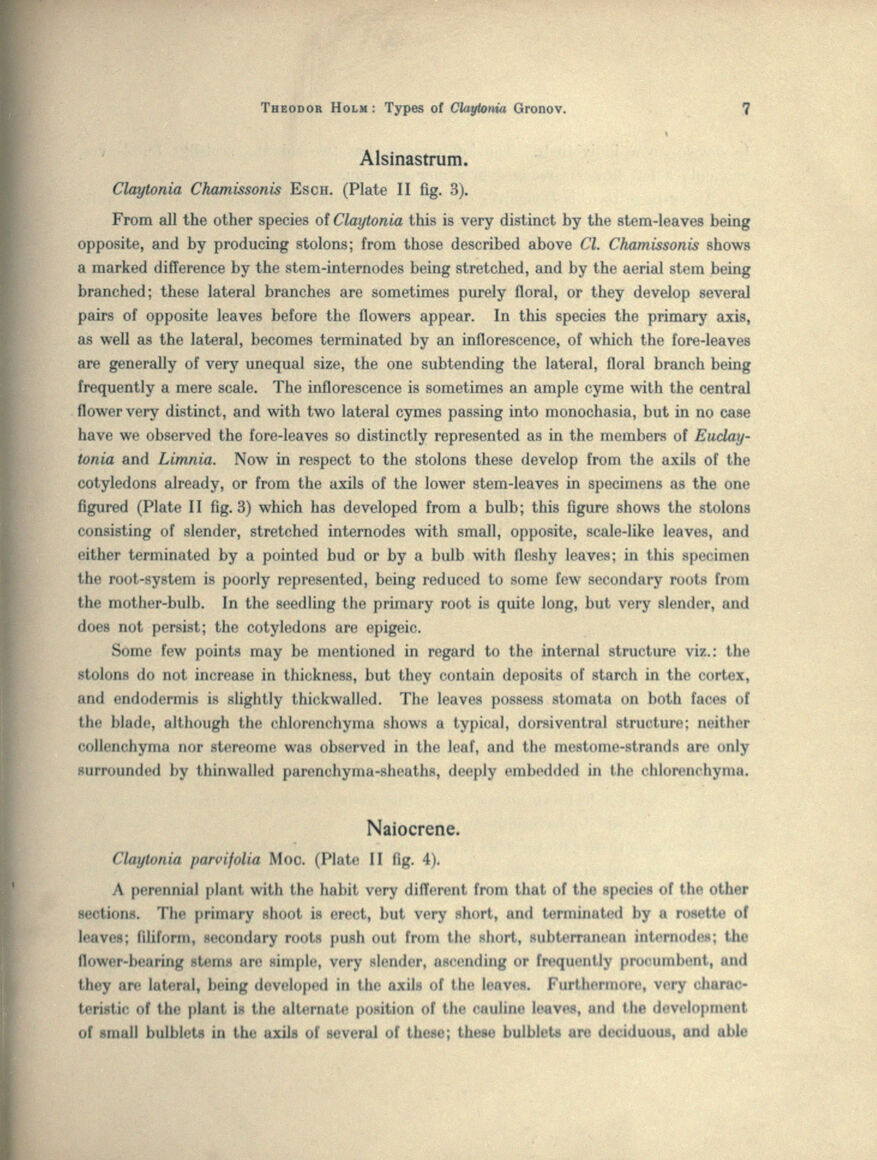
Full resolution (JPEG)
- On this page / på denna sida
- Alsinastrum
- Naiocrene

<< prev. page << föreg. sida << >> nästa sida >> next page >>
Below is the raw OCR text
from the above scanned image.
Do you see an error? Proofread the page now!
Här nedan syns maskintolkade texten från faksimilbilden ovan.
Ser du något fel? Korrekturläs sidan nu!
This page has been proofread at least once.
(diff)
(history)
Denna sida har korrekturlästs minst en gång.
(skillnad)
(historik)
Alsinastrum.
Claytonia Chamissonis Esch. (Plate II fig. 3).
From all the other species of Claytonia this is very distinct by the stem-leaves being
opposite, and by producing stolons; from those described above Cl. Chamissonis shows
a marked difference by the stem-internodes being stretched, and by the aerial stem being
branched; these lateral branches are sometimes purely floral, or they develop several
pairs of opposite leaves before the flowers appear. In this species the primary axis,
as well as the lateral, becomes terminated by an inflorescence, of which the fore-leaves
are generally of very unequal size, the one subtending the lateral, floral branch being
frequently a mere scale. The inflorescence is sometimes an ample cyme with the central
flower very distinct, and with two lateral cymes passing into monochasia, but in no case
have we observed the fore-leaves so distinctly represented as in the members of
Euclaytonia and Limnia. Now in respect to the stolons these develop from the axils of the
cotyledons already, or from the axils of the lower stem-leaves in specimens as the one
figured (Plate II fig. 3) which has developed from a bulb; this figure shows the stolons
consisting of slender, stretched internodes with small, opposite, scale-like leaves, and
either terminated by a pointed bud or by a bulb with fleshy leaves; in this specimen
the root-system is poorly represented, being reduced to some few secondary roots from
the mother-bulb. In the seedling the primary root is quite long, but very slender, and
does not persist; the cotyledons are epigeic.
Some few points may be mentioned in regard to the internal structure viz.: the
stolons do not increase in thickness, but they contain deposits of starch in the cortex,
and endodermis is slightly thickwalled. The leaves possess stomata on both faces of
the blade, although the chlorenchyma shows a typical, dorsiventral structure; neither
collenchyma nor stereome was observed in the leaf, and the mestome-strands are only
surrounded by thinwalled parenchyma-sheaths, deeply embedded in the chlorenchyma.
Naiocrene.
Claytonia parvifolia Moc. (Plate II fig. 4).
A perennial plant with the habit very different from that of the species of the other
sections. The primary shoot is erect, but very short, and terminated by a rosette of
leaves; filiform, secondary roots push out from the short, subterranean internodes; the
flower-bearing stems are simple, very slender, ascending or frequently procumbent, and
they are lateral, being developed in the axils of the leaves. Furthermore, very
characteristic of the plant is the alternate position of the cauline leaves, and the development
of small bulblets in the axils of several of these; these bulblets are deciduous, and able
<< prev. page << föreg. sida << >> nästa sida >> next page >>
Project Runeberg, Sun Dec 10 11:30:00 2023
(aronsson)
(diff)
(history)
(download)
<< Previous
Next >>
https://runeberg.org/japetus100/xxi/0007.html



